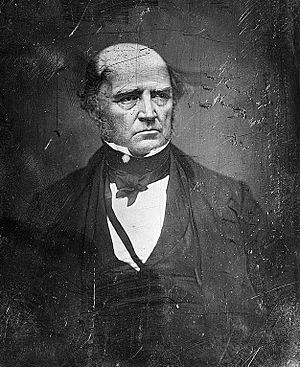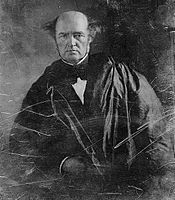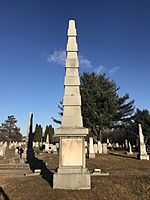Levi Woodbury facts for kids
Quick facts for kids
Levi Woodbury
|
|
|---|---|
 |
|
| Associate Justice of the Supreme Court of the United States | |
| In office September 23, 1845 – September 4, 1851 |
|
| Nominated by | James K. Polk |
| Preceded by | Joseph Story |
| Succeeded by | Benjamin Robbins Curtis |
| 13th United States Secretary of the Treasury | |
| In office July 1, 1834 – March 4, 1841 |
|
| President | Andrew Jackson Martin Van Buren |
| Preceded by | Roger Taney |
| Succeeded by | Thomas Ewing |
| 9th United States Secretary of the Navy | |
| In office May 23, 1831 – June 30, 1834 |
|
| President | Andrew Jackson |
| Preceded by | John Branch |
| Succeeded by | Mahlon Dickerson |
| 9th Governor of New Hampshire | |
| In office June 5, 1823 – June 3, 1824 |
|
| Preceded by | Samuel Bell |
| Succeeded by | David Morril |
| United States Senator from New Hampshire |
|
| In office March 4, 1841 – November 20, 1845 |
|
| Preceded by | Henry Hubbard |
| Succeeded by | Benning Jenness |
| In office March 16, 1825 – March 3, 1831 |
|
| Preceded by | John Parrott |
| Succeeded by | Isaac Hill |
| Personal details | |
| Born | December 22, 1789 Francestown, New Hampshire, U.S. |
| Died | September 4, 1851 (aged 61) Portsmouth, New Hampshire, U.S. |
| Political party | Democratic-Republican (Before 1825) Democratic (1828–1851) |
| Spouse | Elizabeth Woodbury |
| Education | Dartmouth College (BA) Litchfield Law School |
| Signature | |
Levi Woodbury (December 22, 1789 – September 4, 1851) was an American lawyer, judge, and politician from New Hampshire. He was a member of the Democratic Party. During his long career, Woodbury held many important jobs. He served as an Associate Justice on the Supreme Court of the United States. He was also a U.S. Senator, the ninth governor of New Hampshire, and a cabinet member. He worked for Presidents Andrew Jackson and Martin Van Buren. In 1848, some people wanted him to run for President of the United States.
Woodbury was born in Francestown, New Hampshire. He started his own law practice there in 1812. After serving in the New Hampshire Senate, he became a judge on the New Hampshire Supreme Court in 1817. He was Governor of New Hampshire from 1823 to 1824. From 1825 to 1831, he represented New Hampshire in the U.S. Senate. During this time, he joined Andrew Jackson's Democratic Party. He later became the United States Secretary of the Navy under President Jackson. He also served as the United States Secretary of the Treasury for both President Jackson and President Martin Van Buren.
He returned to the U.S. Senate from 1841 to 1845. Then, President James K. Polk asked him to join the Supreme Court. Woodbury was the first Supreme Court Justice to have gone to law school. He received a lot of support to become the presidential candidate at the 1848 Democratic National Convention. Many people from New England wanted him to be president. However, Lewis Cass from Michigan won the nomination instead. Woodbury continued to serve on the Supreme Court until he passed away in 1851. He died from a stomach illness.
Early Life and Career
Levi Woodbury was born in Francestown, New Hampshire. His parents were Mary and Peter Woodbury. He went to Atkinson Academy for his early schooling. In 1809, he graduated from Dartmouth College. He also briefly attended Litchfield Law School in Litchfield, Connecticut. After studying law, he became a lawyer in New Hampshire in 1812. He was the first Supreme Court justice to have attended law school. From 1812 to 1816, he worked as a private lawyer in Francestown. He also joined the Freemasons, a social group.
His strong education helped him start his law career early. This led to his many important political jobs later on. While in Francestown, he wrote papers defending President Madison's choices during the War of 1812. This was the start of his political involvement. Because of his writings, he became well-known. In 1816, he was appointed as clerk of the New Hampshire State Senate. Soon after, he became a judge on the Superior Court of Judicature from 1817 to 1823.
In 1823, he was elected Governor of New Hampshire. Even though there were some disagreements within his party, Woodbury won the election easily. He served as governor for one year. During this time, he tried to bring together different political groups. Woodbury was known for being independent and moderate throughout his career.
After being governor, he served as the Speaker of the New Hampshire House of Representatives in 1825.
Working for the U.S. Government
Serving in the Senate and Cabinet

Woodbury became a U.S. Senator for New Hampshire in 1825. He served until 1831. During this time, he led the Senate Commerce Committee from 1827 to 1831. In 1831, he was elected to the New Hampshire State Senate. However, he did not take that job. Instead, President Andrew Jackson appointed him as United States Secretary of the Navy. He held this position from 1831 to 1834. In this role, he helped appoint Edmund Roberts as a special diplomat to the Far East.
From 1834 to 1841, Woodbury served as United States Secretary of the Treasury. He worked under both President Jackson and President Martin Van Buren. He then served another term as Senator for New Hampshire from 1841 to 1845. After that, he became a justice on the U.S. Supreme Court, serving from 1845 to 1851.
As a U.S. Senator, Woodbury was a strong supporter of President Jackson. He helped to close the Second Bank of the United States. Like Jackson, he preferred an "independent" treasury system. This meant the government would handle its own money, rather than using private banks. He also preferred "hard money" (gold and silver) over paper money. After the financial crisis of 1837, Woodbury realized the U.S. Treasury needed a safer way to manage its money. He supported a law for an "Independent Treasury System," which passed in 1840. This system was later fully established in 1846.
Time on the Supreme Court
In the 1844 presidential election, Woodbury supported James K. Polk, the Democratic candidate. In 1845, President Polk chose Woodbury to be an Associate Justice of the Supreme Court of the United States. He took the place of Justice Joseph Story. Woodbury was officially sworn into office on September 23, 1845. The United States Senate confirmed his appointment on January 3, 1846.
People generally liked the news of Woodbury's appointment. He was seen as someone who would protect people's constitutional rights. As a justice, he wrote important opinions for the Court. These opinions dealt with topics like contracts, slavery, and the power of Congress to regulate trade.
He was considered a possible candidate for president at the 1848 Democratic National Convention. He had a lot of support, especially from New England. However, he did not get the nomination. Woodbury stayed on the Supreme Court until he passed away in 1851 at age 61. He died in Portsmouth, New Hampshire.
Woodbury's Legal Views
Woodbury's writings help us understand his decisions as a justice. They show that he believed in a strict interpretation of the Constitution. This means he thought judges should follow the Constitution's exact words. He was one of the few justices at the time who wrote about legal topics outside of his official rulings. Woodbury cared about individual rights even before the Court focused on them. He also thought slavery was wrong.
When making decisions, Woodbury followed the powers given in the Constitution. He believed that slavery was mentioned in the Constitution. However, he thought Congress could limit it. In his rulings, he upheld the Fugitive Slave Clause in the Constitution. This clause required states to return escaped enslaved people.
Jones v. Van Zandt Case
Even though Woodbury died before the famous Dred Scott v. Sandford case in 1857, he helped set a legal example. He wrote the main opinion for the Court in the case of Jones v. Van Zandt (1847). Van Zandt was an abolitionist in Ohio. He helped enslaved people escape. He was sued for $500 for breaking the Fugitive Slave Act of 1793. The main question was if the Fugitive Slave Act was constitutional.
Woodbury ruled in favor of the rights of slaveholders. He said that the compromises made when the Constitution was written, like the Fugitive Slave Clause, meant states had to enforce the act. As a strict interpreter of the Constitution, he defended slaveholders' rights because they were protected by the Constitution. This was true even though he personally disagreed with slavery. Woodbury believed that slavery was a political issue. He thought each state should decide on it. He stated that the Court had to follow the Constitution and laws. This decision helped strengthen the idea that slavery was part of the Constitution. It also showed that slaveholders' rights were protected. This ruling helped set the stage for the Dred Scott decision later on.
Contract Clause Cases
Woodbury also helped shape how the Court understood the Contract Clause. This clause protects agreements. His time on the Court was a confusing period in Supreme Court history. In Planters' Bank v. Sharp (1848), Mississippi passed a law. This law stopped a state bank from transferring notes to other banks. The state did this because the banking system was unstable. The Court had to decide if Mississippi's law broke any contracts the state or others had with Planters' Bank.
Woodbury ruled in favor of the bank. He found that the Mississippi law went against the Contract Clause in the Constitution. He explained that the law broke two types of contracts. First, it broke the contract in the bank's original charter with the state. Second, it broke the contract made by people who signed notes with the bank. Woodbury said these contracts were valid. This was because a bank had the power to make them for its business. Justices Taney and Peter V. Daniel disagreed. They thought states should have more control. Woodbury's leadership helped strengthen the Contract Clause.
Commerce Clause Cases
Woodbury also helped define how the Commerce Clause should be understood. This clause gives Congress power over trade. In the License Cases, he created a way to decide how much power states had to regulate trade. His ideas later led to the Cooley Doctrine. In the License Cases, the Court looked at state laws that controlled liquor sales. The justices could not agree on one main opinion. This was because there was no clear rule about how much power states had over trade.
Woodbury's opinion focused on looking at each case individually. He did not use a general rule about trade power. He said that buying and selling within a state belonged to the state's power over its own trade. He compared this to the federal government's power over foreign trade. He explained the difference between banning liquor sales on a certain day and banning imports. Banning imports would interfere with the federal government's trade power. Woodbury looked closely at the details of each case. The Court later followed his reasoning in Cooley v. Board of Wardens. In that case, the Court decided to rule case-by-case. They would see if the issue was local or needed national laws. Woodbury's opinion helped bring about this change.
Woodbury also defended states' rights in Waring v. Clarke. This case was about federal power over shipping accidents. A ship accident happened on the Mississippi River near New Orleans. The Court had to decide if the federal government or Louisiana had power over the case. Woodbury disagreed with the idea that the federal government had power over every river affected by ocean tides. He argued that people in accidents on the water would have to travel far if the federal government was involved. He thought it was better to settle disputes locally. He warned that expanding federal power too much could cause problems. He said it could lead to "a struggle for jurisdiction between courts of the states and courts of the United States." This could harm the country's political system. He supported states' rights. This showed how he would rule in future cases, especially those about slavery.
Legacy and Recognition
Levi Woodbury is one of only a few people who served in all three branches of the U.S. government. He is also one of three people who served in all three branches and as a U.S. governor. The others were Salmon P. Chase and James F. Byrnes. Many places are named after him. These include Woodbury County, Iowa; Woodbury, Minnesota; and Woodbury, Tennessee. Woodbury Avenue in Portsmouth, New Hampshire is also named for him. There is also Woodbury School in Salem, New Hampshire. Several ships called the USS Woodbury were named in his honor. A New Hampshire historical marker (number 43) in Francestown also recognizes him.
His daughter Mary married Montgomery Blair. Blair was Abraham Lincoln's Postmaster General. His son, Charles L. Woodbury, was a lawyer. He served as a U.S. Attorney and in the New Hampshire and Massachusetts state legislatures.
Works
- Political, Judicial, and Literary Writings (edited by N. Capen, Boston, 1852)
See also
- Harrison Gray Dyar
- Levi Woodbury Homestead
- List of justices of the Supreme Court of the United States



